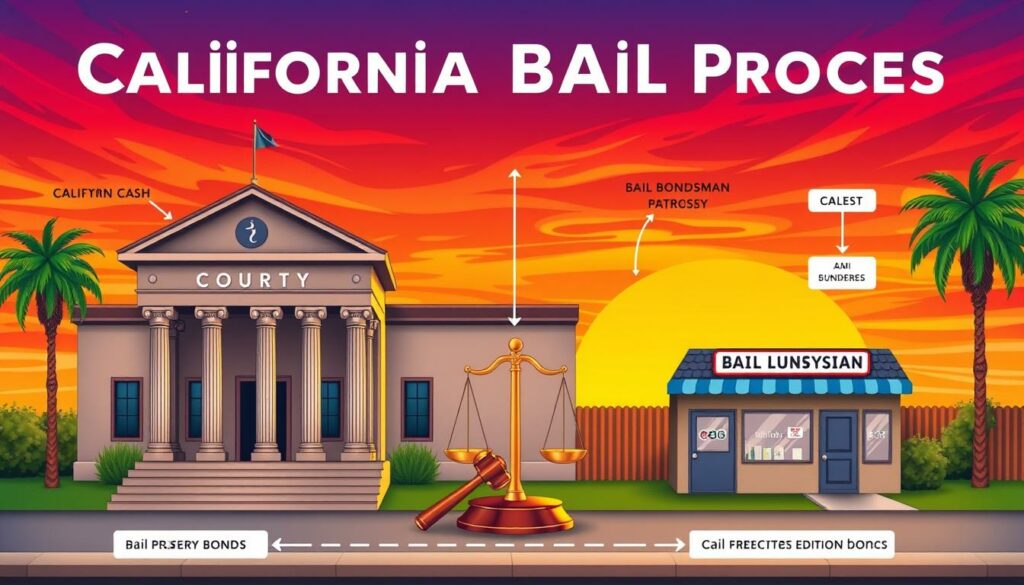
27 Jan How Does Bail Work in California?
The bail system in California is key to the state’s justice system. It lets defendants out of jail before trial. This way, they can get ready for their defense and keep up with their daily lives. It’s important for those charged with crimes or their families to know how bail works.
Bail is a promise of money that ensures a defendant shows up in court. When arrested, a person might get bail. This means putting up money or property as a guarantee. This system balances public safety with individual rights.
The bail system in California tries to keep people from being held in jail too long. It makes sure defendants come back to court. The process looks at the crime, the defendant’s past, and their community ties. Armstrong Bail Bonds assist in making sure your rights in bail are understood.
Key Takeaways
- Bail allows defendants to be released from custody before trial
- It serves as a financial guarantee for court appearances
- The bail amount depends on various factors
- California has different types of bail options
- Understanding the bail process is key for defendants and families
Understanding the California Bail System Basics
The California bail system is key in the state’s justice process. It balances safety with individual rights, letting defendants stay free until trial. Let’s look at the main parts of this system.
Definition and Purpose of Bail
Bail is a financial promise to the court. It ensures a defendant shows up for future court dates. The bail bond process in California protects both the accused and society. By posting bail, people can keep living their lives while their case goes on.
Legal Framework in California
California’s bail laws are detailed. They come from state constitutions and statutes. The Eighth Amendment of the U.S. Constitution limits excessive bail. In California, specific codes control bail procedures. These laws set how bail is determined, posted, and managed during legal actions.
Rights and Responsibilities
Knowing your rights after bail is key. Defendants have the right to fair bail amounts. They can ask for bail reduction hearings. Once out, people must follow court-ordered rules. This might include regular meetings or travel limits.
| Rights | Responsibilities |
|---|---|
| Request bail hearing | Attend all court appearances |
| Seek legal representation | Comply with release conditions |
| Appeal excessive bail | Avoid new criminal charges |
Understanding the California bail system is important. It’s vital for defendants and their families to know the process, their rights, and duties when dealing with bail.
How Does Bail Work
The bail process in California starts when someone is arrested and taken to jail. It’s key to understand bail for those in the criminal justice system. Here are the main steps in the bail process.

After an arrest, a judge sets the bail amount. This amount is based on the crime’s severity and the defendant’s risk of fleeing. The bail is a financial promise that the accused will show up for court.
Once bail is set, there are several ways to post it:
- Cash bail: Paying the full amount directly to the court
- Bail bonds: Working with a bail bond agent who charges a premium
- Property bonds: Using real estate as collateral
Many choose to work with a bail bond agent. In California, these agents charge a 10% premium of the bail amount. This fee is not refundable, even if the charges are dropped or the defendant is found innocent.
| Bail Amount | Bond Premium (10%) |
|---|---|
| $10,000 | $1,000 |
| $50,000 | $5,000 |
| $100,000 | $10,000 |
After posting bail, the defendant is released. It’s important to remember that this release comes with conditions. These include attending all court appearances. Not following these conditions can lead to losing the bail and facing more legal trouble.
Types of Bail Available in California
California has different bail options for people arrested. Knowing about these bail bonds is key for those in the legal system. Let’s look at the main types of bail in California and what they offer.
Cash Bail
Cash bail means paying the full bail amount in cash. It’s fast but needs a lot of money. If you show up for all court dates, you get your cash back, minus fees.
Surety Bonds
Surety bonds are a common choice in California. A bail bond agent posts the bond for a fee, usually 10% of the bail. This makes bail easier for those without enough cash.
Property Bonds
Property bonds use real estate as collateral. The property must be worth more than the bail. This option doesn’t need cash upfront but risks losing property if you miss court.
Release on Own Recognizance
In some cases, a judge lets you go without paying bail. This doesn’t cost money but has strict rules, like attending all court dates.
| Bail Type | Advantages | Disadvantages |
|---|---|---|
| Cash Bail | Quick release, full refund possible | Requires large upfront payment |
| Surety Bonds | Lower upfront cost, widely available | Non-refundable fee |
| Property Bonds | No immediate cash needed | Risk of property loss |
| Own Recognizance | No financial cost | Limited availability, strict conditions |
The Bail Setting Process
The bail hearing process in California is detailed. Judges carefully weigh different factors. They aim to balance public safety with the defendant’s rights.
Factors Determining Bail Amount
Several key elements influence bail amount calculation:
- Nature and severity of the offense
- Defendant’s criminal history
- Ties to the community
- Flight risk assessment
- Public safety concerns

Role of the Judge
Judges evaluate these factors during bail hearings. They have the power to set, modify, or deny bail. Their decisions aim to ensure court appearances and protect community safety.
Bail Schedule Guidelines
California counties use bail schedules as a starting point for bail amounts. These guidelines offer consistency but also allow for flexibility. Bail amounts in California can vary a lot, depending on local policies and case details.
| Offense Type | Typical Bail Range |
|---|---|
| Misdemeanor | $500 – $5,000 |
| Non-violent Felony | $10,000 – $50,000 |
| Violent Felony | $50,000 – $1,000,000+ |
Understanding these factors can help defendants and their families better navigate the bail process. It’s important to know that bail amounts can be negotiated or appealed if seen as too high or unfair.
Posting Bail in California
Understanding the bail bond process in California is key. The most common way is to work with a licensed bail bondsman. You’ll need to pay up to 10% of the bail amount upfront.
There are a few ways to post bail in California:
- Cash bail: Pay the full amount directly to the court
- Bail bonds: Work with a bondsman who posts bail for a fee
- Property bonds: Use real estate as collateral
To begin the bail bond process in California, gather info about the defendant. This includes their full name, booking number, and charges. Then, reach out to a trusted bail bond agency to talk about terms and fees.
Jail release procedures differ slightly by facility. But, they generally follow these steps:
- Bail amount is set by the court
- Defendant or family contacts a bail bondsman
- Paperwork is completed and fee is paid
- Bondsman posts bail at the jail
- Defendant is released, usually within a few hours
Remember, posting bail in California comes with duties. The defendant must show up to all court dates and follow any court or bail bondsman rules. Not doing so can lead to losing the bond and getting arrested.
Working with Bail Bond Agents
In California, many people turn to bail bondsmen when they face legal troubles. These professionals are key in the justice system. They help defendants get out of jail while they wait for their trial.
Bail Bondsman Requirements
California bail agents must follow strict rules. They need to pass a state exam and go through background checks. They also have to keep learning to stay up-to-date. This makes sure bail bondsmen are ready for the bail process.
Premium Payments and Fees
The cost of bail often includes a non-refundable premium, usually 10% of the bail. Some bail bond companies offer lower rates for those who show they’ll attend court. There might also be extra fees for things like monitoring or paperwork.
| Service | Typical Cost |
|---|---|
| Bail Bond Premium | 10% of bail amount |
| Processing Fee | $25 – $100 |
| Monitoring (if required) | $5 – $15 per day |
Bondsman Responsibilities
Bail bondsmen have big jobs. They make sure their clients show up in court. If someone skips bail, they might hire bounty hunters. They also help connect the defendant with the court, giving important advice along the way.

Working with good bail agents in California can help a lot. Knowing what bail bondsmen do and the costs helps defendants get through the bail process better.
Bail Conditions and Restrictions
When you’re released on bail in California, you must follow certain rules. These rules are key to understanding the bail system. Bail eligibility in California comes with duties to keep everyone safe and ensure you return to court.
Court Appearance Requirements
The main rule of bail is to show up for all court dates. If you miss a court date, you could face arrest and have your bail revoked. It’s important to stay updated on your court schedule and arrive on time for every hearing.
Travel Restrictions
Many bail agreements limit where you can travel. You might need permission to leave the county or state. These rules help make sure you don’t flee and are available for court. Sometimes, you might have to give up your passport.
Additional Conditions
Courts may add extra rules based on your case:
- Regular check-ins with a bail agent
- Drug or alcohol testing
- Electronic monitoring
- Restraining orders
- Firearm restrictions
It’s important to understand and follow these bail conditions. Breaking any rule can lead to your bail being revoked and you being sent back to jail. Always talk to your attorney or bail agent if you have any questions about your bail terms to make sure you’re following them correctly.
Consequences of Bail Violations
Breaking bail rules in California can have serious effects. If you violate bail, you could face arrest and more charges right away. The bail process in California is strict and must be followed closely.
Not showing up in court is a big no-no. It can be seen as a misdemeanor or felony, based on the original crime. Remember, bail violations can hurt your case and make getting bail again hard.
- Forfeiture of bail money
- Loss of any collateral posted
- Additional fines and penalties
The court might take away your bail and lock you up right away. This can mess up your defense and limit your trial prep. It’s key to keep talking to your bail bond agent and the court to avoid any misunderstandings.
| Violation Type | Potential Consequences |
|---|---|
| Failure to Appear | Arrest warrant, additional charges |
| Breaking Travel Restrictions | Bail revocation, fines |
| Contacting Prohibited Individuals | Immediate arrest, new charges |
| Violating Curfew | Bail modification, increased restrictions |
It’s vital to know and follow bail rules. Violations can cause big legal and financial problems. They can affect your freedom and future court cases. Always talk to your lawyer to understand your bail conditions and duties.
Rights and Legal Options During the Bail Process
Knowing your legal rights is key when dealing with bail in California. The process can be tough, but understanding your options can greatly affect your case.
Right to Bail Hearing
Every defendant has the right to a bail hearing. This is your chance to argue for release or a lower bail. A judge will look at your risk of flight and public safety. Preparing well for this hearing is very important.
Bail Reduction Options
If the bail seems too high, you can ask for a reduction. Courts might lower it based on your ties to the community, job, and past crimes. A good lawyer can make a strong case for a lower bail, saving you money.
Legal Representation
A skilled attorney is very helpful during bail. They can explain your legal rights after bail and bail bond requirements. They can also talk to prosecutors and present your case to the judge.
Remember, while the Eighth Amendment limits excessive bail, it doesn’t mean bail is always available. Knowing your state’s bail laws is key to getting through the system well.
| Legal Right | Description | Importance |
|---|---|---|
| Bail Hearing | Opportunity to present case for release or lower bail | Can significantly impact release conditions |
| Bail Reduction | Request to lower initial bail amount | Potential for substantial cost savings |
| Legal Counsel | Representation by an attorney | Crucial for navigating complex legal processes |
Conclusion
The California bail system is key in the state’s criminal justice. Knowing how bail works in California is vital for those in the legal system. This guide explains the different bail options, like cash bail and surety bonds.
The bail process can be tricky. It includes many steps, from setting bail to meeting court rules. Defendants need to know their rights, like the right to a bail hearing. Getting legal advice is wise to follow all rules.
Bail reform talks are ongoing in California. Keeping up with new laws and changes is important. Whether you’re a defendant, family member, or concerned citizen, understanding the bail system helps. It lets you make smart choices and handle the process well.
For any questions, please don’t hesitate to contact us here at Armstrong Bail Bonds!

